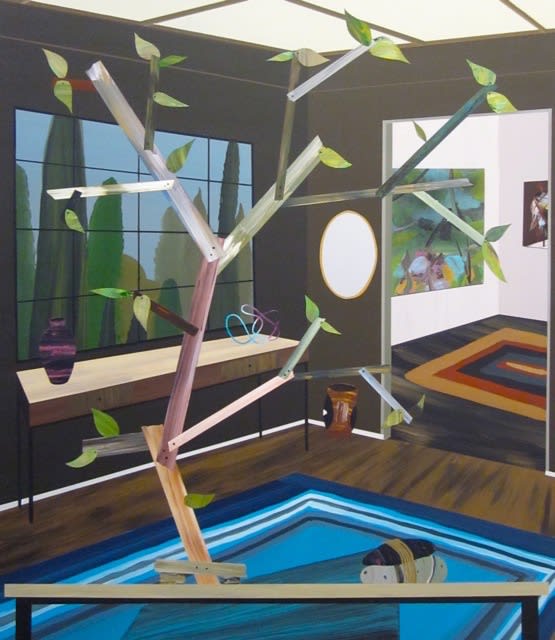Landscape painter Paul Wackers has come indoors. Idle/Idol, his current show at Eleanor Harwood Gallery, features mostly domestic interiors and still lifes in place of the buoyant, metaphysical landscapes that made his reputation. Having recently relocated to Brooklyn from the Bay Area, Wackers is looking for his new subject. Carefully examining the objects around him—rocks, beads, plants, and favorite ceramics—he is also inventing a pictorial space for them. Surprisingly, his schematic perspectives and spatial compression evoke early Cubist experiments with landscape and still life, as well as the early studio interiors of Matisse. Perhaps he’s been frequenting the New York museums as well.
Tree (2011) and Nothing to See Here (2011) feature abstracted plants on tabletops situated in interiors. In the first painting, a constructed tree balances on a beam at the extreme lower edge of the picture. A homemade contrivance, its stems and branches are tacked together by rivets. Its sparse leaves are collaged fragments that terminate at the ends of the branches. Wackers, like Braque, is a master of faux finishes, and the grainy wood floor and bright carpets establish a carefully delineated perspective. On the far wall, a gridded picture window reveals and bars the view outside. Hanging on walls in the painting’s second room are two Wackers pictures, which extend the perspective and echo the inaccessible virtual landscape. A stark white oval situated squarely in the center of Tree functions to flatten the whole, in much the same way Matisse’s black ovals did. (Matisse also painted his own paintings into his pictures. In The Red Studio [1911], paintings hang and are propped on walls in a skeleton architecture overwhelmed by a vibrant red that is floor, wall, ceiling, and air.)
In Wackers’ Nothing to See Here, a giant split leaf philodendron fills the entire frame. Its cutout spray-painted leaves and thick wiry stems press against the picture plane to create a claustrophobic space. The perspective box of the room is indicated by the receding borders of a carpet and two small landscapes on opposing side walls. (In one, a tiny wolf bays at the moon.) The rear wall is a blank grid—perhaps a window—underpinned by a stone wall. Elements of a virtual outside inhabit the virtual inside.
Tree, 2011; acrylic on panel, 48 x 40 in. Courtesy of the Artist and Eleanor Harwood Gallery.
Wait for It, 2011; acrylic and spray paint on panel, 60 x 48 in. Courtesy of the Artist and Eleanor Harwood Gallery.
The Presentation of Choices Made (2011) depicts a curated collection of unrelated objects or talismans in a reflective glass vitrine lit from above.
Plants, rocks, crystals, pots, and circular bands are simplified and rendered in bold strokes, each one painted differently. Do they embody memories for the painter? Wackers lifts them out of context, isolating and highlighting them, suggesting that significance, meaning, and value are conferred, not intrinsic.
The three new landscapes in the exhibition display Wackers’ virtuoso paint handling and his repertoire of styles and textural effects. Conceptually, they are studies in space compression, jamming foreground and background elements together. In Happy Camper (2011), a stream flows horizontally across the canvas, dividing two jumbled, crowded banks. On the near bank a pile of objects (Are they rocks? Clothes? The things they carried?) is reminiscent of obelisk piles seen in Wackers’ previous paintings. The objects are illuminated by and bound with lassos of vibrating neon spray paint. An assemblage of boulders and foliage on the opposite bank merges with foreground elements to undermine any feeling of spaciousness. Wait for It (2011), another closely cropped view, features a fretwork of lashed and painted poles draped with cords, threads, string, and beads, which create a gestural web of geometric and flowing lines across the picture plane. A pie-shaped “compass” establishes a floor in the forest, while dense foliage fills the negative space. A bar of silver spray paint lights up the scene with a fluorescent glow.
Human vision is discontinuous. A single visual record of an object or a vista represents a patchwork of stitched together glances over micromoments in time. This multiplicity of impressions is what Picasso and Braque captured and recorded in their early analytic Cubist paintings. The resultant works had fractured, faceted surfaces with a haptic, almost tactile sensibility. Paul Wackers uses the same technique in his landscapes, juxtaposing and binding disparate forms, fusing foreground and background together to destroy any sense of rational pictorial space. He carefully choreographs illusionistic light sources within his pictures, making the occasional stroke of metallic spray paint all the more startling. A viewer’s eye travels across the disjointed canvas actively stitching together the patchwork of techniques, textures, and colors.
There is a sharp sense of nostalgia in this show. Wackers seems to be taking inventory, arranging, making comparisons, presenting the “choices made.” It will be interesting to see if he can invest his interiors with the power and punch of his former dramatic outdoor work. At the moment, he is a quiet intimist—on hold—recalculating and responding to new cues.
IDLE/IDOL IS ON VIEW AT ELEANOR HARWOOD GALLERY, IN SAN FRANCISCO, THROUGH MAY 14, 2011.
© ART PRACTICAL 2011 - HOSTED AT SOFTSYS.COM


